Table of contents
What is DMAIC?
Lean Six Sigma DMAIC is a data-driven technique that improves processes. This is an important tool in Lean Six Sigma but can also be used as a standalone improvement technique or part of other process initiatives such as LEAN. This technique is simple but powerful. It provides structure and allows teams to explore possible solutions, determine a course of action and then implement process controls quickly.
The DMAIC process is a five-phase strategy that can be used to improve a variety of organizational processes. It can be used for software development, manufacturing, and other purposes. This strategy is often associated with Six Sigma but can be used to improve other processes. DMAIC, a data-driven technique for problem-solving, is designed to identify inefficiencies and improve the process’ outcomes.
The acronym stands to denote the five phases: Define, Measure Analyze, and Improve, Control and Control. It is pronounced.
The DMAIC process is rooted in the PDSA (“plan. do. study. act”) cycle that Walter A. Shewhart, a statistician at Bell Laboratories, developed in the 1930s. The technique we know today was shaped by the biggest companies in the world, such as Toyota, Motorola, and GE. Read more about Six Sigma and DMAIC history.
Why is it important?
It is important that your company has a clear plan for achieving your goals when trying to improve a process. The DMAIC process’s main advantage is its structured but simple approach. Organizations will struggle to track what is working and how it’s changing or eliminate any that aren’t. Even the most successful process changes will not be implemented if there are no effective controls.
This approach requires extensive documentation and is structured. It allows businesses to improve their problem-solving skills and increase productivity. The data gathered can be used to support other projects in the same company, providing better baselines.
Before we get into the main steps, there is an additional step that many companies use to determine if the DMAIC process is the best approach to solving their problems. “Recognize” is the name of this step.
This step is crucial, even though it is not part of DMAIC. Lean Six Sigma DMAIC is not applicable to all situations. This technique is best suited for specific situations. DMAIC can be used to improve your process. It is important to recognize the right conditions and choose the right problem.
How can you assess these conditions? These are the main factors you should consider:
- The existing process is not perfect and has inefficiencies.
- Variables such as lead time or other flaws can be reduced while increasing productivity and cost savings can be achieved.
- The condition can be assessed, and the results can be understood through quantitative means.
Once you’ve evaluated all the factors above, you can determine whether your process could benefit from DMAIC.
Breakdown of the DMAIC Process
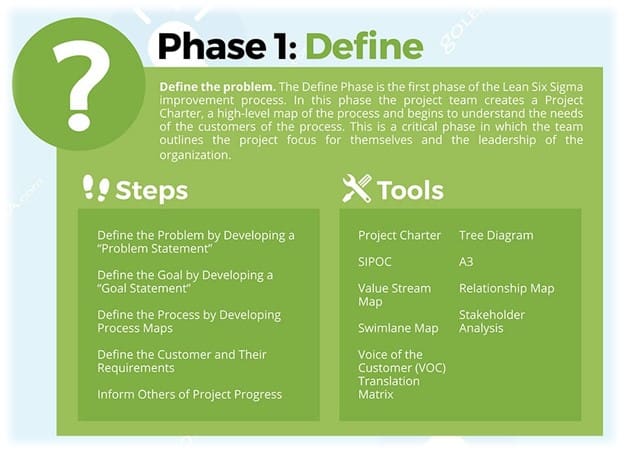
Define
The first phase of Lean Six Sigma improvement is to define the problem and the goal. Which problem do you want to solve? The project team creates a Project Charter and plots a high-level map of their process. They also clarify the requirements of process customers. They begin to build their process knowledge by conducting quantitative/qualitative analysis and speaking with process participants. The team refines its project focus before moving to the Measure Phase. This ensures that they are aligned with organizational leadership goals.
The Lean Six Sigma DMAIC process is a methodology that helps to identify unidentified problems. The issue (or “Y”) must be clearly defined in quantifiable and concrete terms. A Lean Six Sigma group will choose options that best reflect the organization’s goals and the needs of the end-users. This will take place during the Definition phase. This group is searching for CTQs that have a dramatic impact on quality. The “vital few”, distinguished from the “trivial many” is made by this selection. This is the map of the future process.
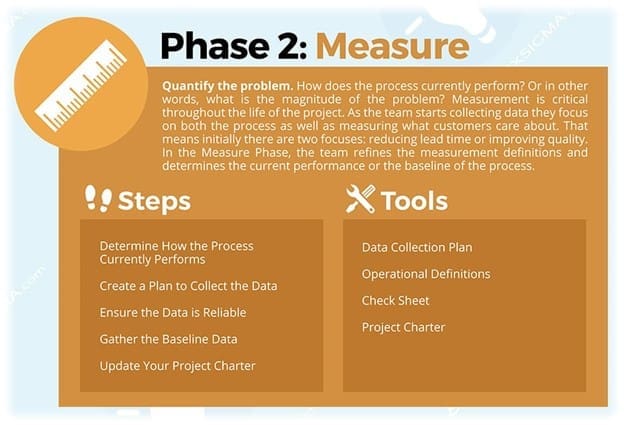
Measure
How does this process perform currently? How large is the problem? Measuring is crucial throughout the project’s life. It provides key indicators about process health and clues as to where issues are occurring. The lead-time of the process and the quality are the main focus of the data collection. The Analyze Phase begins when the team defines its measures and determines the current performance, or the baseline.
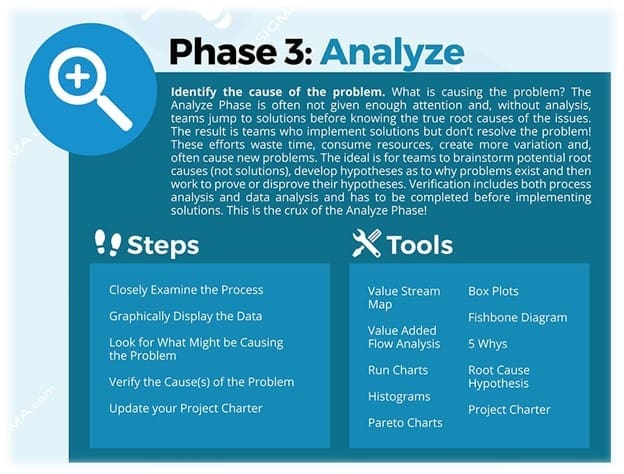
Analyze
What is the problem? The biggest challenge for teams is to resist the temptation to rush to solve the problem before understanding the root cause of the process issues. Teams can implement solutions without proper analysis that don’t solve the problem. This wastes time and increases variability, which in turn could lead to new problems. This is what you’ve seen in teams. It happens all the time. Instead of trying to solve the problem by implementing solutions that aren’t effective, it’s better for teams to take their Process Walks, analyze their charts, and then use their observations to create and confirm theories about the root cause. This phase is crucial because it validates hypotheses and then implements solutions. The team should then move on to the Improve Phase.
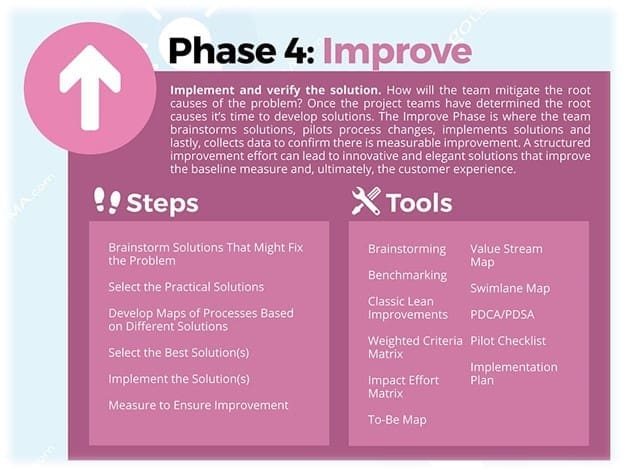
Improve
How will the team address the root causes? After identifying the root cause of the problem, the team can begin to implement solutions. The Improve Phase is where they refine their countermeasure ideas and pilot changes. Finally, they collect data to verify that there has been a measurable improvement. Structured improvement efforts can result in innovative and elegant improvements that improve the baseline measurement and ultimately the customer experience.
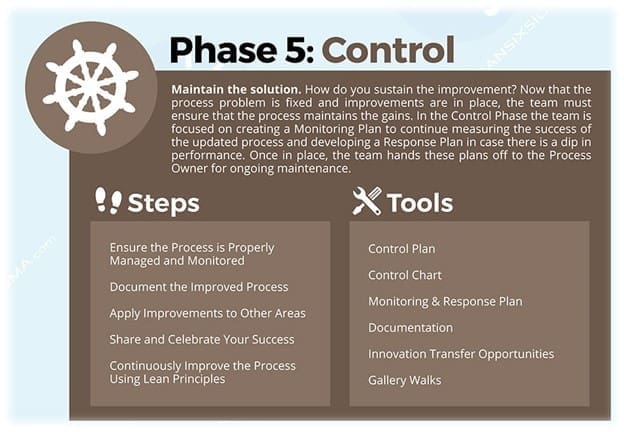
Control
How can you maintain the improvements? Once the problem is fixed and improvements made, the team must continue to improve the process and ensure that it’s easy to keep up with best practices. The Control Phase is where the team creates a Monitoring Plan that tracks the progress of the process. It also crafts a Response Plan for any dips in performance. Once the Process Owner has been established, the Team Member continuously monitors to ensure the best possible method is maintained.
How to Deploy the DMAIC process
Sometimes, people will work on lean six sigma DMAIC process projects alongside their daily responsibilities. If a problem is not urgent or will take a lot of time to resolve, this is a great option. A Kaizen, or rapid improvement event, is used in other situations. This allows project team members to be freed from all other responsibilities and allows them to concentrate on the DMAIC project. This is a great option when the problem is urgent or when it is reasonable for a solution to be found within three to five working days.
When should the DMAIC process be used?
DMAIC can be used to improve existing processes. Lean Six Sigma DMAIC process is a great choice when there is a complex problem or a high risk of inaction. DMAIC helps improve the likelihood of success by bringing discipline to the process and dissuading teams from skipping important steps. For most important projects, DMAIC should be used or another structured improvement process.












